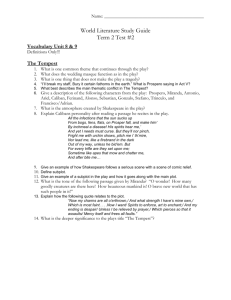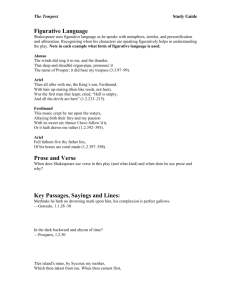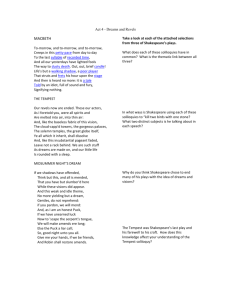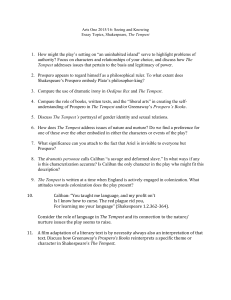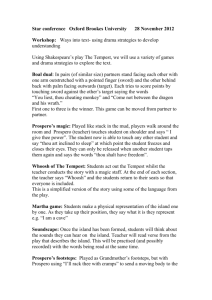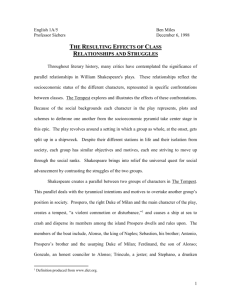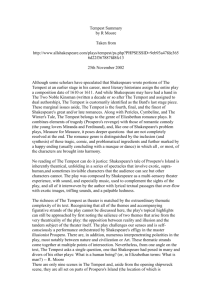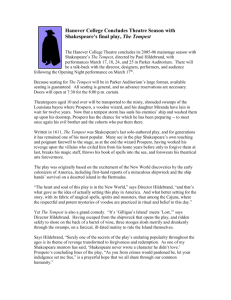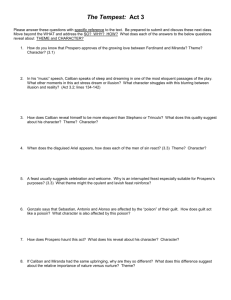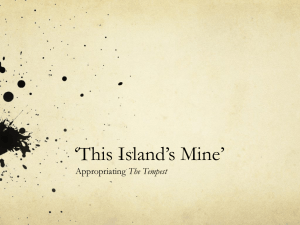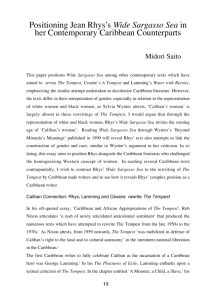Tempest activities.pub - Shakespeare Theatre Company
advertisement
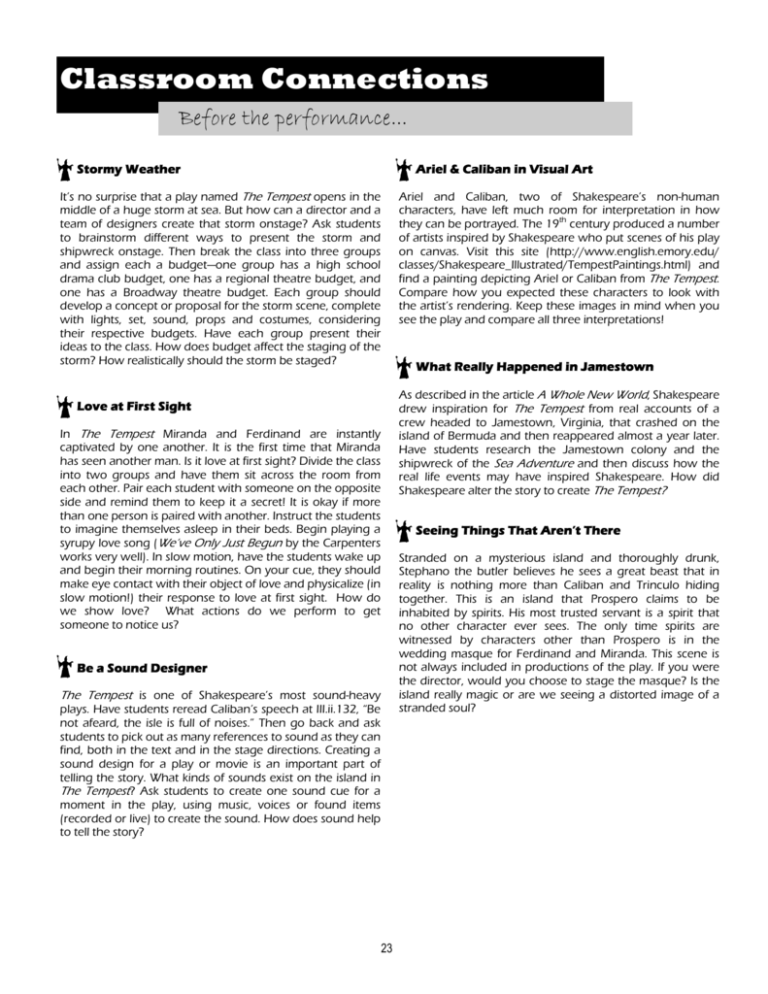
Classroom Connections Before the performance... Stormy Weather Ariel & Caliban in Visual Art It’s no surprise that a play named The Tempest opens in the middle of a huge storm at sea. But how can a director and a team of designers create that storm onstage? Ask students to brainstorm different ways to present the storm and shipwreck onstage. Then break the class into three groups and assign each a budget—one group has a high school drama club budget, one has a regional theatre budget, and one has a Broadway theatre budget. Each group should develop a concept or proposal for the storm scene, complete with lights, set, sound, props and costumes, considering their respective budgets. Have each group present their ideas to the class. How does budget affect the staging of the storm? How realistically should the storm be staged? Ariel and Caliban, two of Shakespeare’s non-human characters, have left much room for interpretation in how they can be portrayed. The 19th century produced a number of artists inspired by Shakespeare who put scenes of his play on canvas. Visit this site (http://www.english.emory.edu/ classes/Shakespeare_Illustrated/TempestPaintings.html) and find a painting depicting Ariel or Caliban from The Tempest. Compare how you expected these characters to look with the artist’s rendering. Keep these images in mind when you see the play and compare all three interpretations! What Really Happened in Jamestown As described in the article A Whole New World, Shakespeare drew inspiration for The Tempest from real accounts of a crew headed to Jamestown, Virginia, that crashed on the island of Bermuda and then reappeared almost a year later. Have students research the Jamestown colony and the shipwreck of the Sea Adventure and then discuss how the real life events may have inspired Shakespeare. How did Shakespeare alter the story to create The Tempest? Love at First Sight In The Tempest Miranda and Ferdinand are instantly captivated by one another. It is the first time that Miranda has seen another man. Is it love at first sight? Divide the class into two groups and have them sit across the room from each other. Pair each student with someone on the opposite side and remind them to keep it a secret! It is okay if more than one person is paired with another. Instruct the students to imagine themselves asleep in their beds. Begin playing a syrupy love song (We’ve Only Just Begun by the Carpenters works very well). In slow motion, have the students wake up and begin their morning routines. On your cue, they should make eye contact with their object of love and physicalize (in slow motion!) their response to love at first sight. How do we show love? What actions do we perform to get someone to notice us? Seeing Things That Aren’t There Stranded on a mysterious island and thoroughly drunk, Stephano the butler believes he sees a great beast that in reality is nothing more than Caliban and Trinculo hiding together. This is an island that Prospero claims to be inhabited by spirits. His most trusted servant is a spirit that no other character ever sees. The only time spirits are witnessed by characters other than Prospero is in the wedding masque for Ferdinand and Miranda. This scene is not always included in productions of the play. If you were the director, would you choose to stage the masque? Is the island really magic or are we seeing a distorted image of a stranded soul? Be a Sound Designer The Tempest is one of Shakespeare’s most sound-heavy plays. Have students reread Caliban’s speech at III.ii.132, “Be not afeard, the isle is full of noises.” Then go back and ask students to pick out as many references to sound as they can find, both in the text and in the stage directions. Creating a sound design for a play or movie is an important part of telling the story. What kinds of sounds exist on the island in The Tempest? Ask students to create one sound cue for a moment in the play, using music, voices or found items (recorded or live) to create the sound. How does sound help to tell the story? 23 Classroom Connections …After the performance Slaves and Servants Water, Water Everywhere In The Tempest, Ariel and Caliban both serve Prospero and Miranda. In the Folio version of the play, Caliban is described as a “savage and deformed slave.” Given that Ariel and Caliban are “natives” of the island, what class issues does their relationship to Prospero bring up? What responsibilities does a director have in staging The Tempest for a contemporary audience? Are Ariel and Caliban positive or negative characters? How would you portray them today? How did the director at The Shakespeare Theatre portray Caliban and Ariel? Water imagery abounds in The Tempest and plays a vital role in the events that unfold. Ask students to share all of the ways that water is used in the play. Then ask students to pick one example of water imagery to recreate. They can make a collage, write a poem, use their bodies, voices, instruments, or any other form of expression to demonstrate the feeling that the water evokes. Adaptation Shakespeare’s plays are continually adapted into other stories and media. For example, Robert Browning’s 1864 poem Caliban Upon Setebos, Franz Marc’s 1914 painting Caliban and the 1956 sci-fi film Forbidden Planet are all based on Shakespeare’s The Tempest. Screen the film, or another film adaptation of the play, look at the painting (see page 19) or read a selection of Browning’s poem (available online at: eir.library.utoronto.ca/rpo/display/poem267.html). How do artists take ideas from literature and incorporate them into their own work? Ask students to create their own work of art based on their response to The Tempest. Possibilities include a drawing, a poem, a short story, a treatment for a screen play or a short video essay. Work can be shared and displayed as students discuss their different responses to the play. Share your students’ work with us by mailing it to The Shakespeare Theatre Education Department. Forgiveness and Reconciliation One of the reasons The Tempest is sometimes considered a comedy is that all the characters are forgiven for their misdeeds. Prospero forgives everyone in the very last scene of the play. Discuss when you think he makes the decision to forgive the characters who have betrayed him. Did those forgiven really repent? Do you think there is a possibility of Prospero being wronged again? Are there any characters who deserve an apology from Prospero? Fathers and Daughters Some Shakespearean scholars believe that in his latter works, the Bard examined more closely the bonds between fathers and daughters because of his relationship with his eldest daughter, Susanna. Reflect on views of father-daughter relationships: What are contemporary views of the roles of fathers and daughters in each others’ lives? What images or stories from television shows, news, movies, books or magazines support these views? How do students see them playing out in their personal experiences? Ask students to compare contemporary views to the relationship of Prospero and Miranda in The Tempest. Look Up at the Sky! Did you know that many of the moons of Uranus are named after Shakespearean characters, many of them from The Tempest? (Those that aren’t Shakespearean are taken from Alexander Pope’s poem, The Rape of the Lock.) For extra credit, ask students to look up the names of the moons of Uranus and find their namesakes in Shakespeare. Are You My Mother? Many female characters in Shakespeare’s later plays grow up never knowing their mothers. Ask students to consider why Shakespeare would make this choice? How would these plays be different if a mother was present? Ask students to rewrite Act I scene ii of The Tempest, adding a third character—Miranda’s mother. How does the scene change? How might this change affect the rest of the play? 24
